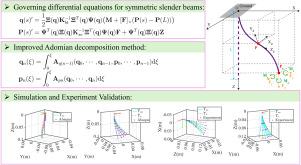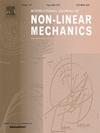An explicit nonlinear model for large spatial deflections of symmetric slender beams
IF 2.8
3区 工程技术
Q2 MECHANICS
International Journal of Non-Linear Mechanics
Pub Date : 2024-09-19
DOI:10.1016/j.ijnonlinmec.2024.104910
引用次数: 0
Abstract
Flexible slender beams are commonly used in compliant mechanisms and continuum robots. However, the modeling of these beams can be complicated due to the geometric nonlinearity becoming significant at large elastic deflections. This paper presents an explicit nonlinear model for large spatial deflections of a slender beam with uniform, symmetrical sections subjected to general end-loading. The elongation, bending, torsion, and shear deformations of the beams are modeled based on Timoshenko’s assumptions and Cosserat rod theory. Subsequently, the nonlinear governing differential equations for the beam are derived from the quaternion representation of the rotation matrix. The explicit load–displacement relations of the beam are obtained using the improved Adomian decomposition method. This method is superior to the classical Adomian decomposition method in terms of convergence rate and domain. The convergence and superiority of the method are also rigorously demonstrated. Simulations are provided to verify the one-, two-, and three-dimensional deflections of beams. Real-world experiments have also been performed to validate our method’s effectiveness with two different beam configurations. The results indicate that the proposed method accurately estimates large spatial deflections of flexible beams.

对称细长梁大空间挠度的显式非线性模型
柔性细长梁通常用于顺从机构和连续机器人。然而,由于几何非线性在大弹性挠度时变得非常明显,这些梁的建模可能会变得复杂。本文提出了一种显式非线性模型,用于计算具有均匀对称截面的细长梁在承受一般端面荷载时的大空间挠度。梁的伸长、弯曲、扭转和剪切变形是基于 Timoshenko 假设和 Cosserat 杆件理论建模的。随后,根据旋转矩阵的四元数表示法推导出梁的非线性控制微分方程。梁的显式载荷-位移关系是通过改进的阿多米分解法得到的。该方法在收敛速度和域方面优于经典的 Adomian 分解法。该方法的收敛性和优越性也得到了严格证明。模拟验证了梁的一维、二维和三维挠度。此外,还进行了实际实验,以验证我们的方法在两种不同梁配置下的有效性。结果表明,所提出的方法能准确估计柔性梁的大空间挠度。
本文章由计算机程序翻译,如有差异,请以英文原文为准。
求助全文
约1分钟内获得全文
求助全文
来源期刊
CiteScore
5.50
自引率
9.40%
发文量
192
审稿时长
67 days
期刊介绍:
The International Journal of Non-Linear Mechanics provides a specific medium for dissemination of high-quality research results in the various areas of theoretical, applied, and experimental mechanics of solids, fluids, structures, and systems where the phenomena are inherently non-linear.
The journal brings together original results in non-linear problems in elasticity, plasticity, dynamics, vibrations, wave-propagation, rheology, fluid-structure interaction systems, stability, biomechanics, micro- and nano-structures, materials, metamaterials, and in other diverse areas.
Papers may be analytical, computational or experimental in nature. Treatments of non-linear differential equations wherein solutions and properties of solutions are emphasized but physical aspects are not adequately relevant, will not be considered for possible publication. Both deterministic and stochastic approaches are fostered. Contributions pertaining to both established and emerging fields are encouraged.

 求助内容:
求助内容: 应助结果提醒方式:
应助结果提醒方式:


